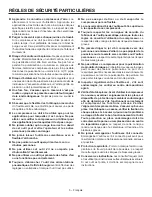
13 – English
MAINTENANCE
WARNING:
When servicing use only identical RIDGID
®
replacement parts. Use of any other parts may
create a hazard or cause product damage.
WARNING:
Always wear eye protection with side shields
marked to comply with ANSI Z87.1. Failure to do
so could result in objects being thrown into your
eyes resulting in possible serious injury.
WARNING:
Before inspecting, cleaning or servicing the
machine, shut off engine, wait for all moving parts
to stop, and disconnect spark plug wire and move
it away from spark plug. Failure to follow these
instructions can result in serious personal injury
or property damage.
GENERAL MAINTENANCE
Avoid using solvents when cleaning plastic parts. Most
plastics are susceptible to damage from various types of
commercial solvents and may be damaged by their use. Use
clean cloths to remove dirt, dust, oil, grease, etc.
As a routine part of air compressor maintenance, it is also
advised that the oil is routinely checked for proper levels.
WARNING:
Do not at any time let brake fluids, gasoline,
petroleum-based products, penetrating oils, etc.,
come in contact with plastic parts. Chemicals can
damage, weaken or destroy plastIc which may
result in serious personal injury.
CHECKING THE SAFETY VALVE
See Figure 17, page 21.
WARNING:
Do not attempt to tamper with the safety valve.
Anything loosened from this device could fly up
and hit you. Failure to heed this warning could
result in death or serious personal injury.
The safety valve will automatically release air if the air tank
pressure exceeds the preset maximum. The valve should be
checked before each day of use by pulling the ring by hand.
Start the air compressor and allow the tank to fill. The
compressor will idle when the pressure reaches the preset
maximum.
Turn off the air compressor.
Pull the ring on the safety valve to release air for three to
five seconds.
The ring pin must be pushed back into position to stop
the flow of air at high pressure.
WARNING:
If air leaks after the ring has been released, or if the
valve is stuck and cannot be actuated by the ring,
do not use the air compressor until the safety valve
has been replaced. Use of the air compressor in
this condition could result in serious personal injury.
CLEANING EXHAUST PORT AND MUFFLER
Depending on the type of fuel used, the type and
amount of oil used, and/or your operating conditions, the
exhaust port and/or muffler may become blocked with
carbon deposits. If you notice a power loss with your gas
powered tool, you may need to remove these deposits to
restore performance. We highly recommend that only quali-
fied service technicians perform this service.
REPLACING THE SEMI-PNEUMATIC TIRE
Turn off the air compressor.
Remove the screws installed through the tire assembly
and the holes on the left and right side of the wheel brace.
Remove the tire assembly.
Remove hitch pins on either side of semi-pneumatic tire.
Remove semi-pneumatic tire.
To install new semi-pneumatic tire, see
Installing the
Semi-Pneumatic Tire
in
Assembly
.
CLEANING THE PUMP AIR FILTER
See Figure 19, page 21.
Turn off the air compressor.
With one hand, secure the pump air filter cover. With the
other hand, remove the hex bolts and washers securing
the cover.
Remove the cover.
Remove the air filter from the cover.
Wash the air filter with warm, soapy water.
Rinse and squeeze to dry.
Reinstall the air filter.
Place the air filter cover back on the unit. Reinstall hex
bolts and washers. Tighten to secure.
CLEANING THE ENGINE AIR FILTER
See Figure 20, page 21.
A dirty air filter will cause starting difficulty, loss of
performance, and shorten the life span of the engine. Check
the air filter monthly. For best performance, replace the air
filter at least once a year.
Turn off the air compressor.
Push the tab on the air filter cover to open, then remove
the air filter cover.














































